infonoise
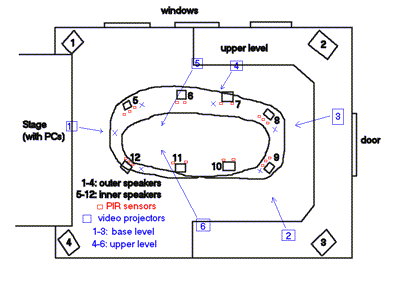
|
more from the e-mail exchange (dec. 2000)
hi again here are some diagrams I made, to try to clarify some of the more detailed technical questions about the equipment etc. The diagrams are probably wrong, so some feedback would help - I am happy to re-draw them. I thought it might be valuable to have them for reference... The "components" diagram shows 13 computers, I have depicted them as being networked using a hub. Also, I have shown 6 computers dedicated to the sound, and 6 to the vision. This may be wrong, in that each computers could manage sound and vision simultaneously. The "projectors" diagram depicts the projectors around the strip with only a plausible coverage. The exact placement of the proj's will depend on the exact design of the sculpture, but clearly the two are closely tied. Is there a better way to draw this diagram, or a more specific way to depict the strip in this sort of a technical drawing? The "speakers" diagram shows how the 12 speakers are positioned, and also specifies the minimum size of the speakers (small ones for the sculpture, larger ones for the room). The "sensors" diagram depicts so-called wide-angle PIRs, with a 90 degree field. I have sketched different arrangements of sensors but settled on this one for some reason, I guess because of the specific overlappings. This overlapping could be a problem with sensor arrangement, but could also be used to advantage. I'm not sure if this particular arrangement will work with the statistical analysis procedure that we discussed. So there they are, four diagrams, and probably all wrong. best wishes Rainer
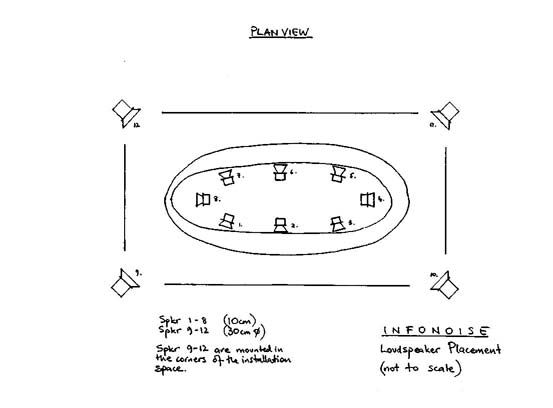
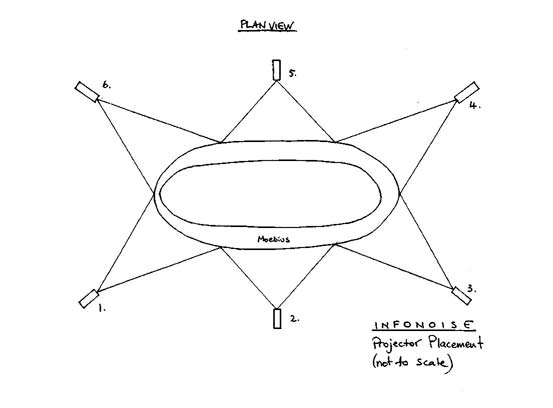
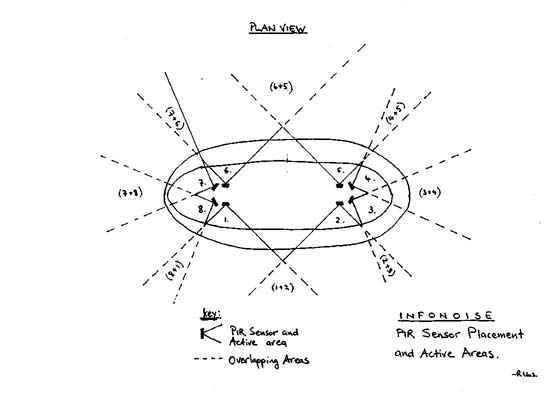
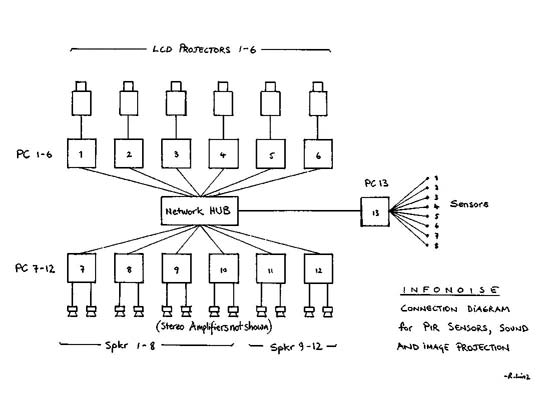
Hi Rainer
Belive it or not, all your diagrams are OK. There is just a couple of
things I would like to mention:
- First, the disposition of the projectors is just a little bit different:
the first projector is inside the strip, facing the vertical part of the
surface, and therefore its projection axis is horizontal; all the others
are at regular intervals, so that the fourth is above the horizontal part
of the Moebius surface, and its projection axis is vertical (that's the
highest one of them all). All the projectors are orthogonal to the surface
of the strip they are facing, and are equally distant from that surface.
So your diagram is basically OK.
- Second, there should be as much PIRs as we can get; there is no reason
to limit their number to eight, because we would not get enough information
to drive the installation, and would have to put a lot of random "noise"
to make it work unpredictably (without a clear pattern). So I would not
commit myself in fixing the number of PIRs: let's make it undefined (PIR1,
PIR2, ..., PIRn). A small box could be added to the diagram as a multiplexer
for the PIRs.
For the rest, it seems to be as I think it should. I think it's best to
have separate computers for separate tasks, so the rendering process can
be untinterrupted by other tasks. 5,000.00 Aus$ more or less... I think
that the price of all the six "sound" PCs is equal to the price of a single
projector. I hope that sound rendering will be possible with the PII, but
it has to be tested. Java is so demanding...
Maybe just an idea how the projectors overlap: suppose you have a Moebius
strip in virtual space, with six cameras in the exact places where the
projectors are in the real installation. The cameras have the same field
of view as the projectors have (zoom angle, aspect ratio). Now, you split
the strip in six segments, and make them all invisible to the cameras exept
the one each camera is facing. Now you have six images of the strip that,
when projected, cover the strip egde to edge without overlapping. The image
that will be projected is a distorted rectangle that fits into the projection
area, the rest of the image being black. It may be a little confusing, but
the important thing is that I know how to do it (at least I think I know).
I have promised some time ago to write you about the sound panning. Take
the next lines just as an untested approach to the problem: I have not yet
made the software to run it - I got my new PC home just two days ago, and
am still installing the hw&sw to run it (it's a 650Mhz AMD Duron, 64MB RAM
133MHz, 20GBy Quantum lct hard disk, Chaintech 7AJA motherboard, Teac 540A
CD, Lucent 56k modem, etc..- still waiting to get a TV tuner and a 19"
monitor). I already wrote you that I think all the sound files could be on
a single computer, and that the six "rendering" PCs can access them through
the network. It is fast enough (100Mbit LAN?). The main problem is
synchronizing the players: you cannot synchronize a player right in the
middle of the reproduction process. So, all the computers should start
playing a file at the same time, but with volume=0. Now, when you need to
"move" the sound from one place to another, you do it by adjusting the
levels of the relevant players (PCs), keeping the ones you don't need at
level 0 ("level" is synonym to "volume" here). So the same sound will be
played on any speaker you need without having to worry about sync, once
you start them all (at the same time, of course). Adjusting the levels is
a much simpler process, and small time incoherences have no noticeable
effect on the result (I'm talking milliseconds). An error in the play
process of that size on two PCs would create two sounds instead of one.
All we have to do is to start enough players on all PCs (they could be
looped) and to adjust volumes on each player of each PC as needed by the
interactive process. Optionally, some of the players could be interrupted,
and then restarted (resynchronized), but playing another audio sample.
All this restarting would be done with level 0 for all, and so that they
could be ready for the next "headline". I am thinking of a strong
correlation between sound and video, and a much lesser one with the PIR
activation process (the visitors of the installation, or the participants,
whatever you call them).
Regards, Zoran